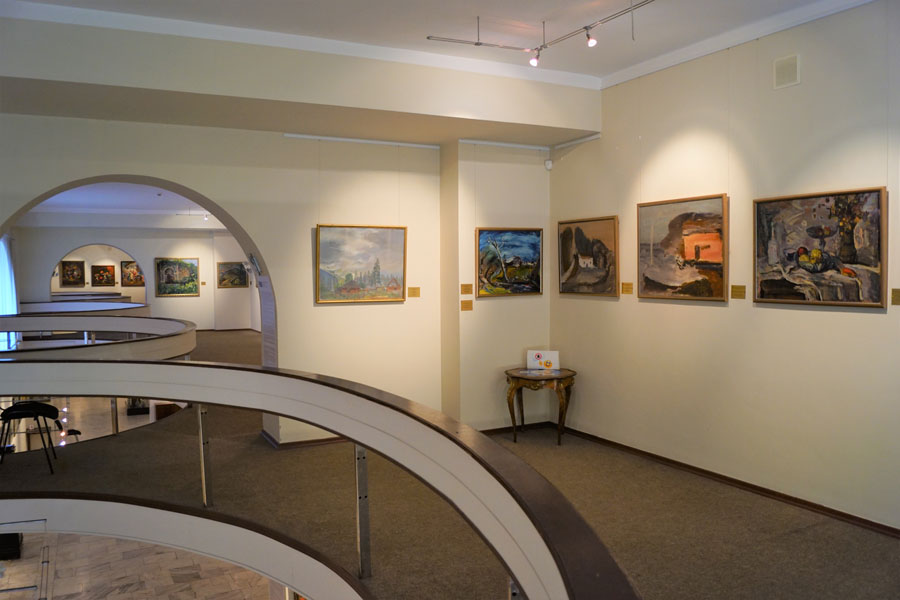The works collected on the second floor have a rather extensive time-span (from 1900 to 1952).
These works are very diverse in their programs; they illustrate the struggle between opposing tendencies and reveal a rich picture of historical and artistic processes in the Russian art of the first half of the 20th century.
The pre-revolutionary years are distinguished by an abundance of different groups and artistic associations, the character of which makes one refer to individual phenomena of Western European art.
I. E Grabar, educated in Munich, whose frequent trips to Paris helped him enrich Russian painting with new artistic means. He did not cease to admire the canvases of the Impressionists, as his works of the early 1900s show. The painting “Carousel” is solved in impressionistic technique, but more energetic and impetuous. The “Carousel” with its frantic rotation is painted with short strokes of pure colors, where objects are devoid of contours, yet acquire other qualities: they sparkle, flash and flicker. As a result, the impression of a festive, motley stir of traveling carnivals is being created.
Dynamics of the development of artistic life in Russia led to the emergence of groups, among which the “Jack of Diamonds” association stands out actively with its outstanding representatives I. Mashkov, A. Lentulov, R. Falk and N. Zaitsev.
I. Mashkov in the still-life “Fruits and Berries” confirms his art as a national artistic version borrowed from the French school, but in Mashkov’s work by the time of its making this influence is formed in a peculiar phenomenon of the Moscow’s followers of Cezanne.
Another representative of the “Jack of Diamonds” is A. Lentulov. Unlike his group fellows, the influence of Cezanne is adopted in a relaxed, lightened version. In the canvases “Children in the Garden,” “Landscape with Trees” the artist works in brightly colored “scraps.” They are being doubled, tripled, changing places, creating a live scene of children sitting in the garden and reading a book.
A somewhat different attitude to color is observed in another member of the “Jack of Diamonds” - P. P. Konchalovsky. In his work “Orchard,” along with all the restraint of the color spectrum, the canvas looks sonorous, bright, thanks to the richness of the shades of green. The author creates the impression of a violent, spontaneous movement of this color with the help of vortex-like strokes that do not remind us the Cubistic polyhedrons of the Cezanne world.
A. Kuprin’s canvas “Gudauty” is painted in long, sweeping strokes, which helps the viewer to imagine the extent of the space where the obstacles in the form of mountains make the world even more powerful and majestic.
A. Osmerkin is represented in the Museum with his Soviet period works, where he remains faithful to the principles of Cezanne and his creative method. His canvass “By the River. A Mill” refers us to Cezanne’s famous work “Banks of the Marne,” almost repeating the composition of the French master.
R. Falk appears before us, when he has already “overcome” the influence of Cezanne departed from this principle to seek and find everywhere the traces of eternity and the inviolability of the world. Later R. Falk paints an “earthy” sphere: poor Paris with its hidden picturesque sadness. He paints the olives of Provence in the spirit of Russian lyrical and poetic landscape; paints his wife, whose sadness is emphasized by his beloved Rembrandt-style gamma, gestures of hands and an expression of face that turns her face into an icon.
N. Udaltsova together with her husband A. Drevin went to Armenia. A sharpened artistic flair helped them to be imbued with the sight of this ancient biblical land, to feel it in all its manifestations: in its landscapes, in the everyday life of Armenians, in the everyday works of the peasants. She, without embellishing anything, makes quick sketches, preserving the freshness and spontaneity of her impressions, which unites her sheets with certain features of expressionism.
A. Drevin in the Museum is represented with his Altaic works, where the remote region of immense Russia attracted him not by exotic, but by the human presence with their daily difficulties (“The Storm in the Steppe”) and joys (“Return to Home”).



